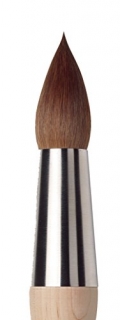Watercolor brushes are brushes that are particularly suitable for painting with watercolor paint. A brush is a tool made of bound hair with which liquid paint can be absorbed and then released again in the painting. Watercolor paints are dissolved and painted with water, so it is important to make sure that watercolor brushes can absorb water well. In addition to the fineness and softness of the hair, flexibility is an important criterion for the quality of a watercolor brush.
The brushes from the hairs of the Siberian Kolinsky-sable have proven to be particularly effective. They are made from the long, soft tail hair of the Kolinsky-sable (a weasel species). However, their price is quite high. Alternatively you can use "normal" red marten brushes, or brushes with artificially made hairs (synthetic watercolor brushes).
Watercolor brush shapes
In addition to the type of brush hair, the shape of the watercolor brush is also important for practical work. One therefore differentiates between watercolor brushes according to the shape of their brush tips:
- Round brush: (the hairs are combined in a round opening of the hair holder and run evenly into the tip, which tapers more and more finely.
- Flat brush: also very suitable for watercolor painting is a flat brush where the opening is flattened. The hairs run evenly to the front, so that a tip descends which is very wide when viewed from above and very flat when viewed from the side.
- Fan brushes: a fan brush cannot absorb much watercolor because its hair radiates from the brush holder. The fan brush is especially suitable for spreading paint on the paper. It is a kind of "restless brush".
- Rigger brush: In contrast to the normal round brush, the tractor brush has much longer hairs. On the one hand it can therefore absorb more paint, and on the other it develops a very dynamic momentum of its own when painting.
- Mop, Washing-brush: is actually a round brush, which is however particularly large and has many hairs. On the surface it is not intended to apply the paint, but rather to paint and spread the paint on the paper with water.

Watercolor Brushes (Types)
The length of the brush handle is a matter of taste. Some prefer to paint with short-stemmed watercolor brushes, others prefer longer stems. However, this doesn't say anything about the quality as a watercolor brush.
Why are Kolinsky red sable watercolor brushes so good?

Kolinsky red sable
watercolor brush
Cost: about 1000 USD
The tail hairs of the Siberian Kollinsky-sable are particularly well suited for watercolor brushes. The reason lies in the structure of its hair: it can absorb a lot of water without dripping. This allows Kolinsky red marten brushes to absorb a lot of liquid paint. Modern synthetically produced hair does not (yet) have these properties. Nevertheless, synthetic brushes are also well suited for watercolor painting.
One of the largest manufacturers of watercolor brushes - or of artist's brushes in general - is the German company da Vinci. So if you really want to buy good watercolor brushes, you are well advised to use red sable natural hair brushes from da Vinci.
Weiterlesen:
- All about Watercolor painting
- Watercolor paint boxes / starter sets
- Some of my watercolor paintings (holiday paintings)
